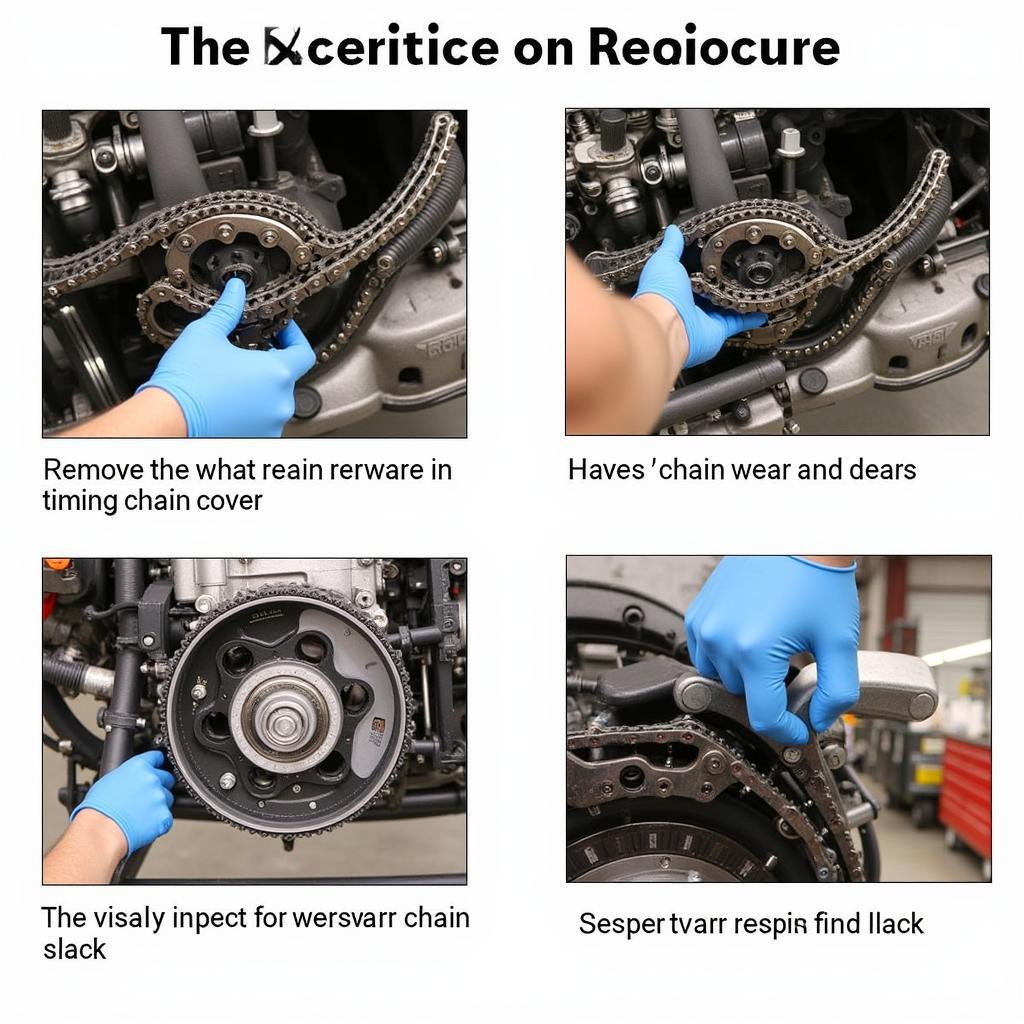Timing chain problems can be a significant headache for car owners. This guide dives deep into the intricacies of timing chain issues, offering valuable insights into their causes, symptoms, and solutions. Whether you’re a seasoned mechanic or a concerned car owner, understanding these issues is crucial for maintaining your vehicle’s health and avoiding costly repairs.
Understanding the Timing Chain’s Role
The timing chain is a vital component of your car’s engine. It synchronizes the rotation of the crankshaft and camshaft, ensuring that the engine’s valves open and close at the precise moments required for optimal combustion. A malfunctioning timing chain can disrupt this delicate balance, leading to a range of performance issues and potentially catastrophic engine damage. Think of it as the conductor of your engine’s orchestra – if the conductor is off, the whole symphony falls apart.
What are the common causes of timing chain problems? Several factors contribute to timing chain wear and tear. These include:
- Lack of lubrication: Insufficient oil or low oil pressure can starve the timing chain of necessary lubrication, leading to accelerated wear.
- Poor maintenance: Neglecting regular oil changes and failing to address minor issues can exacerbate timing chain problems.
- Manufacturing defects: In some cases, timing chains may have inherent defects that contribute to premature failure.
- High mileage: Over time, even with proper maintenance, timing chains can stretch and wear out due to the constant stress they endure.
Identifying Cars with Timing Chain Problems: Key Symptoms
Recognizing the symptoms of a failing timing chain is crucial for preventing further engine damage. Some common indicators include:
- Rattling noise from the engine: A noticeable rattling sound, especially upon starting the engine or during acceleration, can suggest a loose or worn timing chain.
- Engine misfires: If the timing chain is stretched or slipped, the engine’s timing will be off, leading to misfires and reduced power.
- Check engine light: The check engine light can illuminate for various reasons, including timing chain problems. A diagnostic scan can pinpoint the specific issue.
- Difficulty starting the engine: A severely worn or broken timing chain can prevent the engine from starting altogether.
Diagnosing Timing Chain Issues: What to Look For
Diagnosing timing chain problems often requires specialized tools and expertise. A mechanic might use a timing light to verify the engine’s timing or perform a compression test to assess the engine’s overall health. In some cases, removing the timing chain cover might be necessary for a thorough inspection.
 Inspecting the Timing Chain
Inspecting the Timing Chain
“A thorough inspection is key,” says John Miller, a seasoned automotive engineer with over 20 years of experience. “Don’t just assume it’s a minor issue. A failing timing chain can lead to costly engine damage if left unaddressed.”
Addressing Timing Chain Problems: Repair and Replacement
Replacing a timing chain is a complex procedure that typically involves removing various engine components. While some experienced DIYers might tackle this task, it’s generally recommended to entrust this repair to a qualified mechanic.
Preventing Timing Chain Problems: Proactive Maintenance
Preventing timing chain issues involves diligent maintenance. Regular oil changes with the correct oil viscosity are crucial. Addressing any unusual engine noises promptly can also prevent minor issues from escalating into major problems.
“Regular maintenance is your best defense against timing chain problems,” advises Sarah Chen, a certified mechanic with extensive experience in automotive repair. “Sticking to your car’s recommended maintenance schedule can save you a lot of headaches and money in the long run.”
Conclusion: Keeping Your Engine in Sync
Cars With Timing Chain Problems require prompt attention to prevent further damage. By understanding the causes, symptoms, and solutions, car owners can make informed decisions about maintaining and repairing their vehicles. Regular maintenance and proactive attention to any warning signs are essential for keeping your engine running smoothly and avoiding costly repairs down the road. For any assistance or further questions, feel free to connect with us at AutoTipPro. Contact us at +1 (641) 206-8880 or visit our office at 500 N St Mary’s St, San Antonio, TX 78205, United States.
FAQ
-
How often should I replace my timing chain? Consult your car’s owner’s manual for the recommended replacement interval.
-
Can I drive my car with a bad timing chain? It’s not advisable. Driving with a damaged timing chain can lead to catastrophic engine failure.
-
How much does it cost to replace a timing chain? The cost varies depending on the make and model of your car.
-
What are the signs of a stretched timing chain? Rattling noises, engine misfires, and difficulty starting are common indicators.
-
How can I prevent timing chain problems? Regular oil changes and prompt attention to unusual engine noises are crucial.
-
Is it difficult to replace a timing chain myself? It’s a complex procedure best left to a qualified mechanic.
-
What happens if a timing chain breaks while driving? The engine will stall, and you’ll likely require extensive repairs.




Leave a Reply